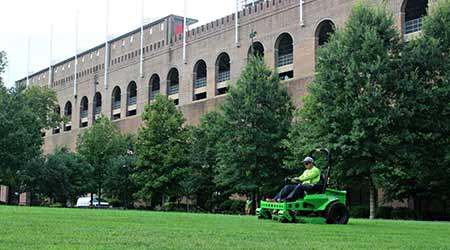« Back to Facilities Management Grounds Management Category Home
Lessons in Landscaping from Major Corporations and Institutions

Crews equipped with zero emission, low noise equipment at the University of Pennsylvania. (Photo courtesy of BrightView.)
January 14, 2019
- Grounds Management
By Missy Henriksen
When we think of the corporate campuses of Fortune 500 companies, we often think of multi-million-dollar construction projects, generous employee amenities, and luxurious CEO office spaces. These companies’ landscapes are just as important as what is behind their office doors. In fact, they are the first thing employees and clients see when they arrive. These top corporations are aware of the important role their landscape play to their brand — and in many cases, occupant satisfaction — and have partnered with landscape professionals to create some of the most beautiful, innovative and impressively landscaped corporate and institutional campuses in the country.
Top corporations and institutions, from Home Depot to Apple to the University of Pennsylvania, work with professional landscape companies to design their landscapes. Although these corporations generally have larger campuses with which to work, more traditional commercial properties can easily emulate their trends on a smaller scale.
To take a look at what’s trending and really resonating with employers across the country, we tapped into some of the country’s leading professional landscape companies to learn more about the top trends of their biggest corporate clients.
Sights and Sounds
Many corporate headquarters are integrating sight and sound design elements into their landscape projects to stimulate the senses. Ruppert Landscape has seen this trend taking off at both large and small commercial properties. They recently incorporated movement and sound into the hardscaping and smell and color into the softscaping of a global communications company’s campus. Aside from aesthetics, installing soothing water features, ornamental grasses, and aromatic plants helps inspire creativity and reduce stress for employees.
Although the trend of adding sight and sound elements to landscapes is taking off, it is unnecessary to go overboard. Ken Thompson, director of quality and efficiency, recommends creating “beauty that appears effortless” as a best practice.
Keep It Natural
Joseph Barnes, marketing director of Yellowstone Landscape, agrees that an effortless look is in. “Over the past several years, we’ve seen a shift in design aesthetics with our commercial clients,” he says. “Today there seems to be a desire for a more natural appearance in their landscapes.”
Yellowstone works with Home Depot at their Store Support Center in Atlanta and has started integrating more native plants and grasses in their landscape designs. Home Depot’s campus includes an outdoor employee recreation center, complete with full-sized basketball courts, volleyball nets, and open field space, so the contractor utilizes native plant selections to keep this area feeling more serene and park-like for employees. Barnes has found that large annual flower displays can take away from the natural beauty of the surrounding natural landscape of Georgia.
For smaller commercial properties looking to take advantage of this natural trend, Barnes recommends incorporating trees, crushed stone, or mulch, rather than large flower displays, concrete, or metal. Doing so also reduces water consumption and minimizes maintenance costs.
Functionality Is Key
One of the biggest trends in landscaping that is relevant for any sized properties is functionality. Pacific Landscape Management regularly creates landscapes that are attractive, yet functional, for large corporate campuses.
Bob Grover, president, suggests functionality as a trend any property can follow, regardless of size. “It’s all about scope and scale,” says Grover.
Many corporate headquarters take advantage of their land by creating plenty of areas for employees to collaborate, work, eat, recreate, and relax. Smaller facilities can do the same by simply by adding trees for shade, building a patio, or even installing picnic tables.
The contractor also recommends that companies work with their landscape team to use turf strategically. “Turf can provide employees and visitors open space for recreation and relaxation, but it should be placed in functional spaces of a landscape design and not where it could be difficult to maintain,” says Grover.
Go Green
Perhaps the most common trend among corporate and institutional campuses right now is sustainability. BrightView, which works on some of the largest national commercial companies’ landscapes including Oracle and Fiat Chrysler USA, is seeing a shift toward sustainability and resiliency. “Companies want to promote their commitment to sustainability as part of their brand message,” says Megan Horn, managing principal.
The contractor has locations across the country and is seeing a focus on water conservation in landscapes, especially in dry areas such as California. Smaller commercial properties can improve water conservation efforts by working with a professional to install irrigation systems, which can also help current landscape conditions become more drought-tolerant.
Working with a landscape professional to create a sustainable landscape isn’t just beneficial to the environment, but also to the company. “They see value in doing so from reducing maintenance, to being more resilient to catastrophic weather events,” says Horn. “And it helps build a positive brand.”
Corporate and institutional landscapes include some of today’s hottest trends and best practices in the management of outdoor spaces, while still maintaining brand identity. Commercial and institutional properties of all sizes can gather inspiration from these top corporate landscapes and incorporate it into their own properties. Partnering with a landscape professional can help bring these trends to life on a property and ensure the landscape is an extension of the brand.
To find a commercial landscape company, visit www.loveyourlandscape.org.
Missy Henriksen is vice president of public affairs for the National Association of Landscape Professionals.








